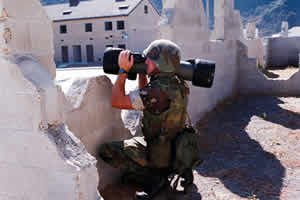
Responding to an urgent request from warfighters, Lockheed Martin expanded the capabilities of its Predator anti-tank weapon and delivered 400 rounds to the U.S. Marine Corps in less than six months, prompting praise from, SRAW project officer Michael Woodson at the Marine Corps Systems Command in Quantico, VA.
The U.S. Marine Corps recently asked Lockheed Martin to modify the shoulder-fired, short-range Predator anti-tank weapon into a direct-attack urban assault weapon for use in Iraq. Renamed the Short-Range Assault Weapon-Multiple Purpose Variant (SRAW-MPV), the new urban assault missile has a multiple-purpose blast warhead instead of a top-attack anti-armor warhead, enabling it to defeat a variety of targets such as buildings and bunkers as well as light-armored vehicles, "technicals," et. al.
These modifications put the weapon in the rare class of a short-range soft-launch assault weapon that can be fired from inside enclosures like buildings with just single hearing protection. In addition, its point-and-shoot, fire-and-forget inertial guidance system minimizes the both gunner exposure and involvement in the middle of a firefight, and corrects for in-flight disturbances such as cross-wind to ensure greater accuracy.
The Lockheed Martin Predator is a lightweight close range anti-tank missile system which complements the Javelin anti-tank missile. The shoulder-mounted fire and forget missile weighs less than 10kg. Predator fills an intermediate role, beneath the Javelin but with a longer range and higher lethality than the AT4 and other assault rockets.
Both the Predator and SRAW-MPV versions are fully ready to deploy.
A total of 700 rounds are due to be retrofitted with the new warhead, which is most of the USA's missile stockpile. In February 2002, the United States Marine Corps signed a contract with Lockheed Martin for low-rate initial production (LRIP) of 330 Predator systems. A second LRIP contract for 400 systems was signed in January 2003, after which further production was cancelled.
Lockheed Martin, MBDA and Insys also came together to propose a modified version called Kestrel for the UK Next Generation Light Anti-Armour Weapon (NLAW) requirement, but lost out to MBT-LAW led by Saab Bofors Dynamics in May of 2002.
Nevertheless, the Predator system may still have a future beyond the current upgrade cycle. The U.S. Army is currently evaluating options for upgrading its urban assault weapon capabilities, and many U.S. allies have similar urban warfare requirements or are considering them in light of Iraq's lessons.
Defense Industry Daily
09.06.2005